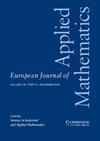Global dynamics and spatiotemporal heterogeneity of a preytaxis model with prey-induced acceleration
IF 1.1
4区 数学
Q1 MATHEMATICS, APPLIED
引用次数: 0
Abstract
Conventional preytaxis systems assume that prey-tactic velocity is proportional to the prey density gradient. However, many experiments exploring the predator–prey interactions show that it is the predator’s acceleration instead of velocity that is proportional to the prey density gradient in the prey-tactic movement, which we call preytaxis with prey-induced acceleration. Mathematical models of preytaxis with prey-induced acceleration were proposed by Arditi et al. ((2001) Theor. Popul. Biol. 59(3), 207–221) and Sapoukhina et al. ((2003) Am. Nat. 162(1), 61–76) to interpret the spatial heterogeneity of predators and prey observed in experiments. This paper is devoted to exploring the qualitative behaviour of such preytaxis systems with prey-induced acceleration and establishing the global existence of classical solutions with uniform-in-time bounds in all spatial dimensions. Moreover, we prove the global stability of spatially homogeneous prey-only and coexistence steady states with decay rates under certain conditions on system parameters. For the parameters outside the stability regime, we perform linear stability analysis to find the possible patterning regimes and use numerical simulations to demonstrate that spatially inhomogeneous time-periodic patterns will typically arise from the preytaxis system with prey-induced acceleration. Noticing that conventional preytaxis systems are unable to produce spatial patterns, our results imply that the preytaxis with prey-induced acceleration is indeed more appropriate than conventional preytaxis to interpret the spatial heterogeneity resulting from predator–prey interactions.具有猎物诱导加速度的猎物大同模式的全局动力学和时空异质性
传统的捕食者捕猎系统假定捕食者的运动速度与捕食者的密度梯度成正比。然而,许多探索捕食者与猎物相互作用的实验表明,在捕食者与猎物的接触运动中,与猎物密度梯度成正比的是捕食者的加速度而不是速度,我们称之为具有猎物诱导加速度的捕食者大同(preytaxis with prey-induced acceleration)。Arditi 等((2001)Theor.Popul.59(3), 207-221) 和 Sapoukhina 等((2003)Am.Nat.162(1),61-76)来解释实验中观察到的捕食者和猎物的空间异质性。本文致力于探索这种具有猎物诱导加速度的猎物-大溪地系统的定性行为,并在所有空间维度上建立了具有均匀时间界限的经典解的全局存在性。此外,我们还证明了在系统参数的特定条件下,空间均质的纯猎物稳态和共存稳态的全局稳定性及衰减率。对于稳定机制之外的参数,我们进行了线性稳定性分析,以找到可能的模式机制,并通过数值模拟证明,具有猎物诱导加速度的捕食-大同系统通常会产生空间非均质时间周期模式。我们注意到传统的猎物大同系统无法产生空间模式,因此我们的结果表明,具有猎物诱导加速度的猎物大同系统确实比传统的猎物大同系统更适合解释捕食者与猎物相互作用产生的空间异质性。
本文章由计算机程序翻译,如有差异,请以英文原文为准。
求助全文
约1分钟内获得全文
求助全文
来源期刊
CiteScore
4.70
自引率
0.00%
发文量
31
审稿时长
>12 weeks
期刊介绍:
Since 2008 EJAM surveys have been expanded to cover Applied and Industrial Mathematics. Coverage of the journal has been strengthened in probabilistic applications, while still focusing on those areas of applied mathematics inspired by real-world applications, and at the same time fostering the development of theoretical methods with a broad range of applicability. Survey papers contain reviews of emerging areas of mathematics, either in core areas or with relevance to users in industry and other disciplines. Research papers may be in any area of applied mathematics, with special emphasis on new mathematical ideas, relevant to modelling and analysis in modern science and technology, and the development of interesting mathematical methods of wide applicability.

 求助内容:
求助内容: 应助结果提醒方式:
应助结果提醒方式:


